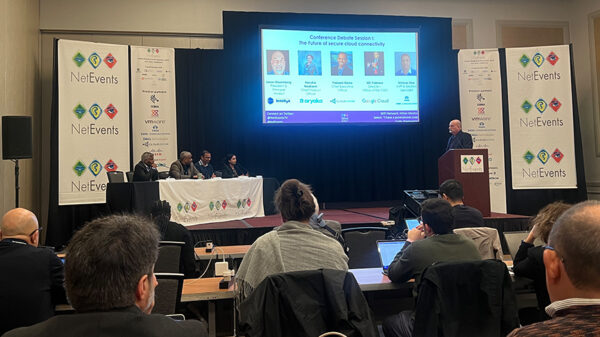By Amir Khan
CEO, Alkira
The origin of “cloud computing” is disputed. One source credits Compaq executives with coining the term in internal documents in 1996, though the first recorded public outing was courtesy of Google CEO Eric Schmidt who used it at a conference in 2006.
Long before it got a name, the IT industry was airing the concepts that would later be associated with the cloud: the first virtual machines date back to the 1950s, while the 1960s gave birth to the idea of “intergalactic computing”, defined as the ability to harness the collective power of networked computers, and Salesforce.com can be credited with the first example of software-as-a-service – originally billed as the “no software” service – in 1999. As early as 2002, Forrester Research was talking about utility computing, the two critical components of which were computing power on demand and pay-per-use charging.
Why the history? Because despite the relative maturity of cloud computing, and its growth to become a multibillion-dollar global industry, it hasn’t yet delivered on its promise of a hardware-less, software-less, scalable, flexible, shackle-free environment in which organisations pay only for what they need.
That’s set to change in 2021, when most analysts are predicting a surge in growth of the cloud market. Gartner forecasts an 18.4% rise in global spending on pubic cloud services to $304.9bn. Other industry watchers are making even more dramatic claims.
Analysts rightly note that the market will be spurred on at least in the short term by Covid-19, which has taught businesses painful lessons about the need for flexibility. Organisations have had to reconfigure systems and networks rapidly to cope with changing working patterns. Whether or not people return to pre-2020 office-bound working practices is a moot point. The lesson that organisations need to be able to flex their IT resources to respond to changing conditions of every kind has been brought home with a vengeance by the pandemic.
While it may create new urgency and insight that is driving cloud use, Covid-19 will not solve the problems holding back successful deployment of the cloud. The catalyst for change here is the development of new solutions to the problems of multi-cloud deployment – a new category of services dubbed network cloud.
Network cloud promises to remove the major barrier to cloud deployment experienced by organisations – typically larger enterprises – with IT investment tied up in legacy applications and systems.
According to Accenture, 90% of enterprises are already using cloud and, of those, the number of clouds they are connected to is on the increase. Flexera’s State of the Cloud 2020 Report says the average enterprise connects to 4.4 clouds and that 93% profess to a multi-cloud strategy. To judge by these figures, the trend to multi-cloud is already well established. But dig a little deeper and the picture changes:
- Cloud use is wide but not deep: the average enterprise has moved only 20-40% of its workload to the cloud (Accenture)
- Organisations do not believe they are getting value for money: 30% of spending on cloud is wasted (Flexera)
- Costs are overrunning: typically enterprises report a 23% overspend on cloud development and are cranking up their 2021 budgets by 47% (Flexera)
- Most are not happy with the results: two-thirds express dissatisfaction (Accenture)
- Businesses are delaying moving legacy applications to the cloud: for the fourth year in a row, the top priority for 73% of respondents to the Flexera survey is optimising the applications already running in the cloud.
For business and IT leaders these statistics tell a familiar, decades-old story about the promise of IT lagging behind reality, but why is the story of cloud still a tale of disappointment?
The answer, in a word, is complexity.
Think of the cloud as a highway with unlimited capacity for traffic. There must be on-ramps and exits for getting traffic on and off, rules to ensure the safety of the traffic on the highway and to spot unlicensed or dangerous drivers before they cause an accident. Now think about multiple clouds – a series of interconnected highways controlled by different authorities and with different rules for drivers depending on which route you travel. Further imagine that the vehicles that use them may need to be modified before they can cross from one major route to the next.
That’s a simple description of what becomes a complicated and time-consuming problem of building a single, secure network connecting data, applications and users in a multi-cloud environment.
No wonder that the ability to configure networks for the cloud, particularly in multi-cloud set-ups has been one of the major factors inhibiting progress.
We’re talking about a process that can take months or even years. Network cloud proponents promise to reduce the network configuration headache to a few clicks and cut the timescale to hours or minutes.
Take just one aspect of network configuration, security. To implement the same security posture in a multi-cloud network today requires tailoring the policy for each environment. Vendors signing up to the network cloud paradigm effectively hide the underlying technical differences allowing the customer to apply a single policy throughout.
Network cloud design doubles the overall firewall capacity through intelligent application traffic steering. This has obvious implications for cost and deployment time.
Another inhibiting factor for cloud is that a large part of the existing IT estate is effectively landlocked, tied up in data centres and on-premises legacy facilities. While the cloud has been used for new applications, moving the legacy estate is still regarded as too difficult for many organisations.
What if connecting an organisation’s data centres across the country or across the globe could also be provided as a cloud service with capacity on demand and pay per use charging? Folding the legacy estate into the cloud proposition would be transformative, marking the end of the experimental phase of cloud deployment. The network cloud leaders have this in their sights for 2021 too.
According to Accenture, “enterprises that continue to delay a shift to cloud at scale aren’t just incurring an opportunity cost, they’re risking their very survival.”
As we survey the inevitable economic damage in the post Covid world, the promise of a 40% reduction in total cost of ownership from network cloud will be compelling. But the bigger prize in the long term is unlocking the full potential of the cloud to empower businesses to grow, change direction or reconfigure as needed, deploy new applications at pace, extract the full value of data, and maximise the opportunity provided by every interaction with customers.
Expect in 2021 to see the long-held promise of IT that moves at the speed of the business finally being fulfilled.





















































































































